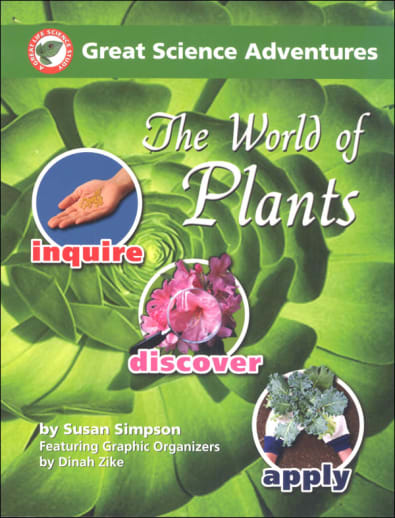The mini-booklets are called "Lots of Science Library Books." Pages from the World of Plants book are cut out and cut or folded in various ways to make into the mini-booklets. Approximately one-fourth of the pages are used to make these mini- booklets. This is an unusual approach, but not surprising, given that co-author Dinah Zike is also the author of Big Book of Books and Activities and The Big Book of Projects, both paper-manipulating activity books. Each mini-booklet addresses a specific question, then includes clear drawings and text to answer the question. Occasionally, one of the mini-book pages is titled "Fascinating Facts" and tells an interesting tidbit relating to the question.
Another quarter of the book is devoted to graphics which are cut out and made into 3D Graphic Organizers. The student makes these into his own visual aid on the topic, such as the parts of a plant, manipulating each part while learning the names and functions of the part.
The remaining half of the book is devoted to Teacher Pages. Lessons are designed to take one to three days to complete. These include vocabulary words, concept maps, assessments, assignments for all grade levels, and enrichment activities for the 24 lessons. Each lesson is laid out in a similar format. The lesson begins with a question, like "How do plants respond to the world around them?" Several basic statements about the concept are then given. Most of the information for the lesson is included in the "Lots of Science Library Book" for the lesson. Learning takes place from assembling the "Lots of ..." books, putting together the 3D Graphic Organizer, and doing the labs, using the "Investigative Loop". This is a term for the systematic process of posing a question, doing research or making predictions, starting a procedure, observing changes, recording data, drawing conclusions, and communicating conclusions, which may lead to another question and a new loop. Materials for the labs are listed and are generally ones that are commonly available. Instructions for the lab are brief. Although the labs are not complicated, some of them require observations over a period of days; the included "Lab Log" will help you keep track of which experiments you will need to observe on what days. All activities and labs indicate which are appropriate for Beginning Level (K-1), Primary Level (2-3), and Intermediate Level (4-8). If using the program for grades 7 and 8, the extension activities are recommended.
If you are looking for a program where students are spoon-fed information from a textbook and the teacher needs little preparation time, look elsewhere. This program is the essence of a hands-on program. For those who learn best by doing, this approach is well worth considering.
Hardcopy, 150-page books which include both textual and how-to information plus reproducible pages.

